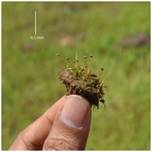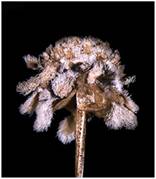Ministry of Science & Technology
Scientists from Agharkar Research Institute, Pune discover two new species of pipeworts from the Western Ghats of Maharashtra & Karnataka
The new species belong to a plant group known for their varied medicinal properties
प्रविष्टि तिथि:
04 OCT 2020 6:15PM by PIB Delhi
Two new species of a plant group known for their varied medicinal properties have been discovered in the Western Ghats – one of the thirty-five hot-spots of biological diversity in the world.
The plant group known as pipeworts (Eriocaulon), whichcompletes their life cycle within a small period during monsoon, exhibits great diversity in the Western Ghats, having around 111 species in India.
Most of these are reported from the Western Ghats and Eastern Himalayas, and around 70% of them are endemic to the country. One species, Eriocaulon cinereum, is well known for its anti-cancerous, analgesic, anti-inflammatory, and astringent properties. E. quinquangulare is used against liver diseases. E. madayiparense is an anti-bacterial from Kerala. The medicinal properties of the newly discovered species are yet to be explored.
Scientists from Agharkar Research Institute (ARI), Pune, an autonomous institute of the Department of Science & Technology, Government of India, have recently found two new species of pipeworts in Maharashtra and Karnataka.
They found the new species while exploring the biodiversity of the Western Ghats. They wanted to trace the evolutionary history of the genus Eriocaulon and made extensive efforts to collect as many species as possible from India, especially from the Western Ghats.
“While critically examining our collection, we came across two accessions, which showed different floral characters than earlier known species. Hence, we studied morphology and its DNA to confirm the novelty,” said Dr. Ritesh Kumar Choudhary, the lead author of the study.
"Identification of the species belonging to Eriocaulon is very difficult as they all look similar, which is why the genus is often referred to as 'Taxonomist’s nightmare'. Its tiny flowers and seeds make it difficult to distinguish between different species," Dr. Choudhary pointed out. Their study was published in the journals 'Phytotaxa' and ‘Annales Botanici Fennici’.

Fig: Eriocaulon parvicephalum
The one reported from Sindhudurg district of Maharashtra was named as Eriocaulon parvicephalum (due to its minute inflorescence size), and the other reported from Kumta, Karnataka was named as Eriocaulon karaavalense (named after Karaavali = Coastal Karnataka region).

Fig: Eriocaulon karaavalense
“Future studies will focus on elucidating the evolutionary history of the genus in India. A thorough investigation of the phylogenetic relationship between all Indian species would also help in prioritizing the conservation of threatened species in India. We are also trying to develop DNA barcodes, which will enable us to identify the species with just a portion of the leaf,” said Dr. Choudhary's Ph.D. student Ashwini Darshetkar.
[Publication links:https://doi.org/10.5735/085.056.0417
https://doi.org/10.11646/phytotaxa.303.3.3
For more details, Dr. Ritesh Kumar Choudhary (rkchoudhary@aripune.org) can be contacted.]
*****
NB/KGS/(DST MEDIA CELL)
(रिलीज़ आईडी: 1661594)
आगंतुक पटल : 1368